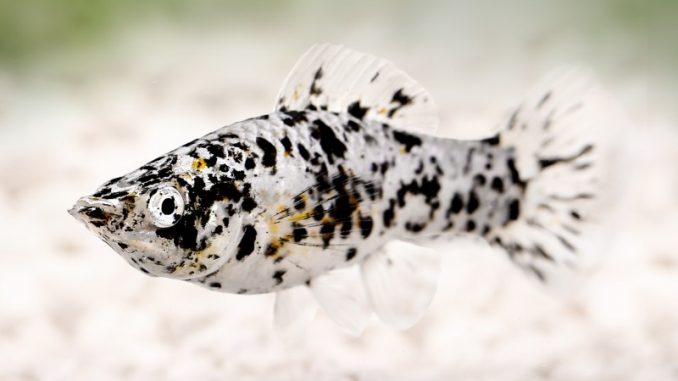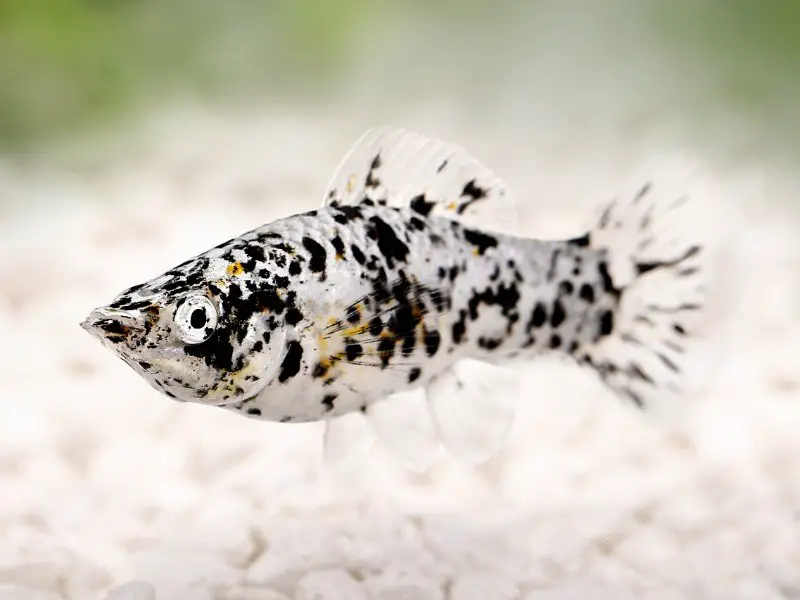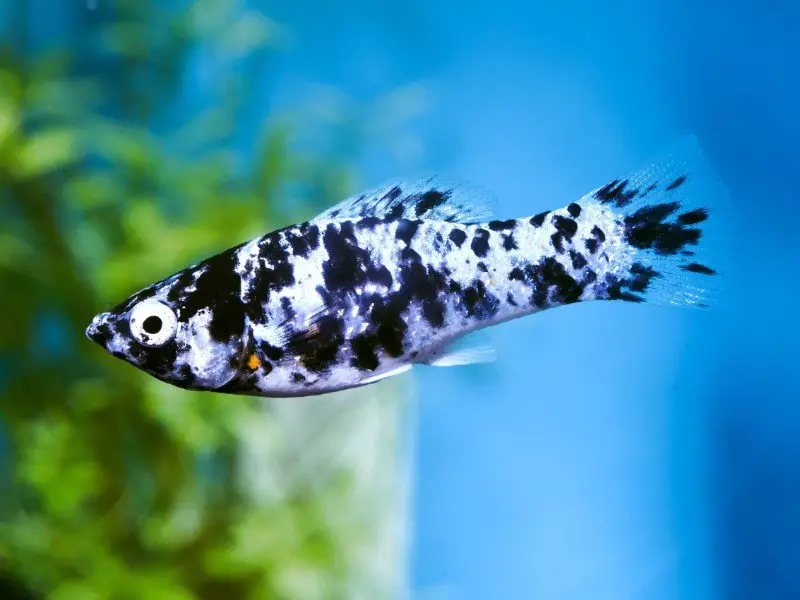
The dalmatian molly is a freshwater fish of the Poeciliidae family. This species is a popular aquarium fish because of its attractive colors and easy care requirements. The fish has a white body with black spots. This species is small, growing up to only 5 inches in length.
TABLE OF CONTENTS
Dalmatian Molly Facts & Overview

| Scientific name: | Poecilia latipinna |
| Common names: | Dalmation molly, marbled molly, sailfin molly |
| Distribution: | Central America, South America, southern North America, Mexico |
| Size: | 3–5 inches |
| Life expectancy: | 3–5 years |
| Color: | White body with black spots |
| Diet: | Omnivore |
| Temperament: | Peaceful |
| Minimum tank size: | 30 gallons |
| Temperature: | 70–82°F (21–27°C) |
| pH: | 7.0–7.8 |
| Hardness: | 12–25 dGH |
| Care level: | Easy |
| Breeding: | Livebearer |
Origin
The dalmatian molly originates from the southern United States, where it was first discovered.
In the wild, the fish inhabit lakes, ponds, rivers, and streams in tropical and subtropical freshwaters.
Dalmatian mollies aren’t picky about their habitats. The fish’s tanks should include hiding places to retreat into during feeding time or if the fish become frightened.
Adult Size and Lifespan
The adult size of the dalmatian molly is 3–5 inches long, and males are smaller than females. In captivity, these fish live up to five years. However, some fish can live as long as 10 years under ideal conditions — with a proper diet and good water quality.
During the breeding season, male dalmatian mollies have a more intense coloration than females. The male also develops breeding tubercles — small, fleshy bumps on his anal fin — when he is ready to mate. The bumps are present during the breeding season but can be difficult to see if the bumps are not swollen enough or if there’s no light shining through them.
Mollies are peaceful fish and do not require much space to thrive. The fish can live in small aquariums as long as there’s enough space to swim around and search for food. The tank should be at least 10 gallons, but a larger tank is better, to provide the fish more space to swim about and exercise its fins.
Availability
Dalmatian mollies are easy to find in pet stores or online. These fish are often sold alongside other mollies to create a mixed-species aquarium. The price for this fish is between $2 and $15 and varies depending on the fish’s size and location.
These fish are sold at chain pet stores like Petco and Petsmart. However, the fish are only available at select times of the year, so they may not always be in stock. Also, look for dalmatian mollies at the following online stores:
Appearance and Behavior
The most striking feature of the dalmatian molly is its coloration — black spots on a white body, resembling a dalmatian dog’s coat.
These fish are hardy and easy to care for, making them popular aquarium pets. This species will readily adapt to new environments if it has been well-cared-for in previous environments.
Colors, Patterns, Fins, and Sex Differences
The dalmatian molly gets its name from the distinctive black-and-white pattern on its body and fins. While the fish’s coloration can vary, it’s usually black-and-white. The dorsal fin has alternating black-and-white bands that run horizontally across the length of the fin. The anal fin has similar coloration but is usually smaller than the dorsal fin. The caudal fin may also have slight variations in color, depending on the subspecies of fish.
Male dalmatians have more intense colors than females. Males can also have slightly longer fins than females, but this difference is not always present. Although males are typically smaller than females, males who have not reached sexual maturity may look identical to females.
Typical Behavior
Dalmatian mollies are generally peaceful, but they can become aggressive if they feel threatened by another fish or by changes in their environment.
The fish are active swimmers and enjoy having plenty of room to explore their surroundings in an aquarium setting. This species tends to hang out at the top or middle section of the tank and is very social and active during the day.
Dalmatian Molly Care and Tank Requirements

Caring for dalmatian mollies is relatively simple, but the fish still have some basic care requirements.
The fish’s tank should contain an aquarium filter and an air stone, or another aeration device, to keep the water clean and oxygenated. The tank should also contain plants, hiding places, and decorations.
Dalmatian mollies are omnivorous and consume meaty foods such as worms, brine shrimp, bloodworms, and algae wafers. Feed the fish two or three times a day.
Habitat and Tank Requirements
Dalmatian mollies are native to southern North America, Central America, and South America. This species’ natural habitat is slow-moving streams and ponds with muddy bottoms. The fish’s care needs aren’t as demanding as many other tropical fish species.
A dalmatian molly’s tank should be spacious with plenty of hiding places and other decorations for the fish to explore. Appropriate water conditions help keep the fish’s skin healthy and prevent fin rot.
Tank Conditions
The dalmatian molly is a freshwater fish that can tolerate a wide range of water conditions, making these fish ideal for beginners. This species is very hardy but does require some specific requirements to thrive.
- Water type: Freshwater
- Tank size: Minimum 30 gallons
- Water temperature: 70–82°F
- Substrate: Fine gravel or sand
- Tank setup: Plants
- Acidity: 7.0–7.8 pH
- Water hardness: 2–25 dGH
- Filter: Yes, to increase water movement
- Bubbler: Essential, to provide fish with breathable oxygen
The tank conditions suitable for dalmatian mollies are relatively easy to maintain. Keep in mind that a bigger aquarium makes it easier to care for fish.
Be sure to check the water’s pH levels regularly and adjust them as needed. Change the pH levels by adding or removing small amounts of water from the tank.
Disease
Even though the dalmatian molly has high disease resistance, the fish can become infected with parasites like Ich (white spot disease) and Trichodina. The best way to prevent these diseases is to maintain good water quality and keep the tank clean. Cycle your tank before adding new fish, and perform regular water changes to keep the tank healthy.
Tank Mates

Dalmatian mollies are active, so they need fast-moving tank mates. Slow-moving tank mates will be chased around the tank, unable to get away from the fast dalmatian molly. Bottom dwellers are also not recommended tank mates.
Suitable fish tank mates for dalmatian mollies include:
- Shubunkins
- Rosy barbs
- Dwarf gouramis
- Guppies
- Platies
- Rasboras
Suitable non-fish tank mates for dalmatian mollies include:
- Freshwater shrimp
- Plants
- Snails
Diet and Feeding

Dalmatian mollies are omnivorous, meaning they eat both plant and animal matter. In the wild, these fish eat small insects, crustaceans, worms, algae, and plants.
In a home aquarium, feed these fish a variety of foods like frozen bloodworms, brine shrimp, and freeze-dried pellets to provide a balanced diet.
Dalmatians should only be fed twice per day — once in the morning and once in the evening. Don’t overfeed these fish as overfeeding can lead to health problems like bloating and constipation.
Breeding
Dalmatian mollies can be bred in two ways: artificial spawning or live breeding. Artificial spawning requires an egg incubator or hatching jar, while live breeding requires a big tank.
For either breeding method, you will need:
- A tank with water at least 1–2 inches deep
- Airstone, or an air pump for oxygenation (1 per 10 gallons)
- Filter with an air pump
- Water conditioner (API Stress Coat)
Should You Get a Dalmatian Molly for Your Aquarium?
A dalmatian molly makes a great addition to home aquariums, particularly for beginner aquarists. This species is beautiful, hardy, and easy to care for. Dalmatian mollies are sure to provide their owner with some entertainment. These mollies are lively and active fish who enjoy swimming around the tank at top speed when they aren’t hiding away under rocks and decorations.

What this guide apply to golddust mollies as well?
Our dalmatian Molly has changed it behavior. It stays on bottom of tank and is rubbing its belly on pebble substrate. What does this mean?